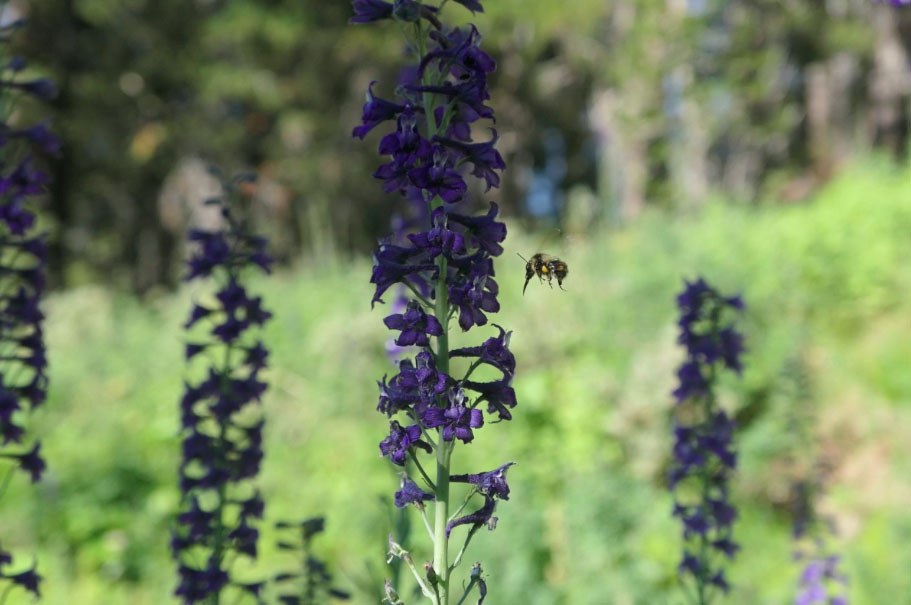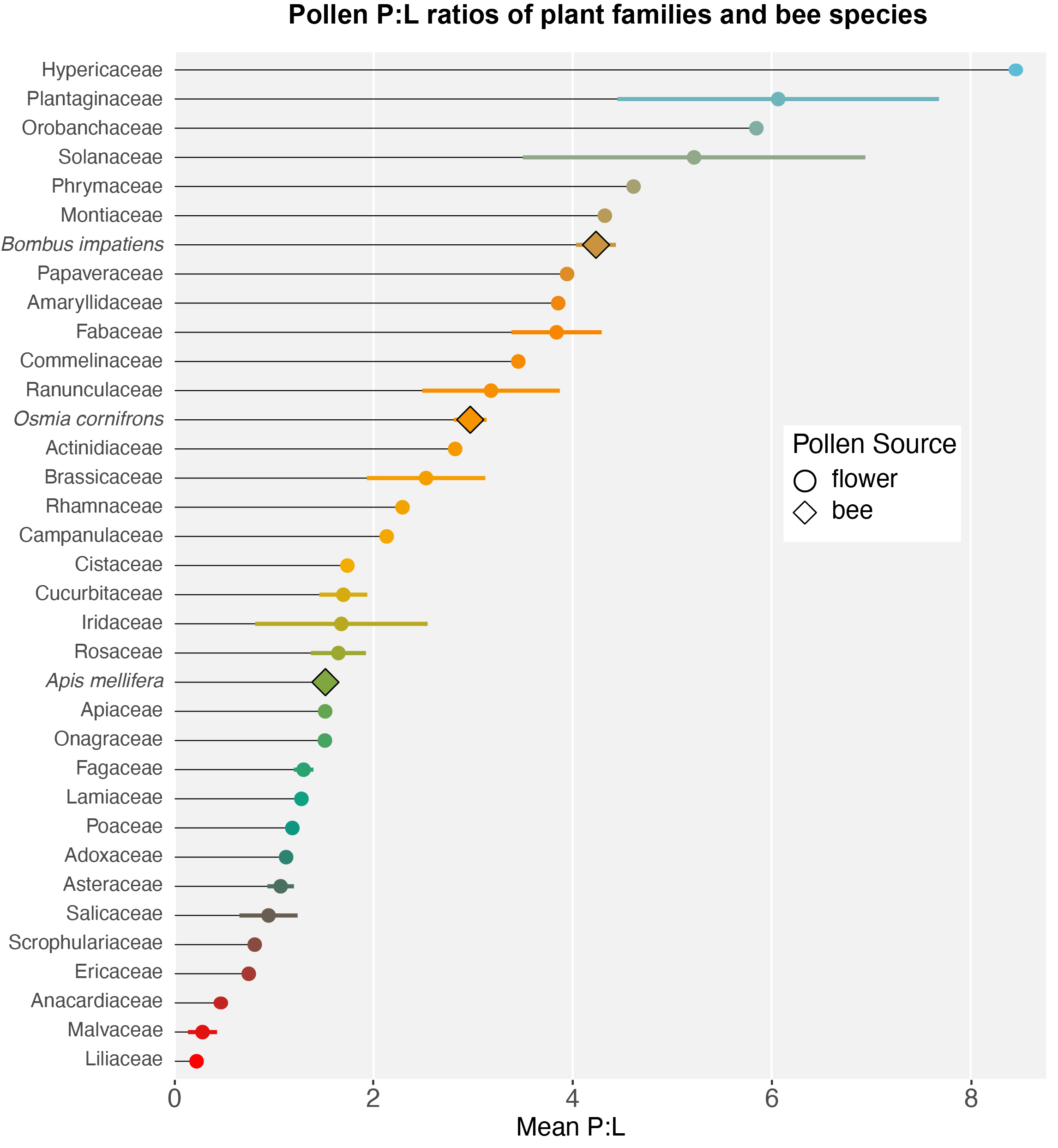Posted: March 23, 2020
Bees balance their protein and lipids from pollen of different flowers. Our new research article analyzes a suite of plant species pollen nutritional values to discover trends in bee-flower interactions. This dataset could help growers, gardeners, and conservationists when selecting plant species to choose for pollinator habitat restoration by providing species rich and nutritionally diverse landscapes.

A bee samples delphinium
Vaudo, A.D.; Tooker, J.F.; Patch, H.M.; Biddinger, D.J.; Coccia, M.; Crone, M.K.; Fiely, M.; Francis, J.S.; Hines, H.M.; Hodges, M.; Jackson, S.W.; Michez, D.; Mu, J.; Russo, L.; Safari, M.; Treanore, E.D.; Vanderplanck, M.; Yip, E.; Leonard, A.S.; Grozinger, C.M. Pollen Protein: Lipid Macronutrient Ratios May Guide Broad Patterns of Bee Species Floral Preferences. Insects 2020, 11(2), 132 (View and download)
The majority of wild and crop plant species' flowers are pollinated by bees. Bee-mediated pollination is achieved by the exchange of floral rewards of nectar and pollen for bees' service of transferring pollen to other flowers to fertilize and set seeds and fruit. The vast majority of bee species obtain all of their nutrients from floral rewards. Nectar is the primary source of carbohydrates for bees. Pollen is their primary source of proteins and lipids. Adult bees collect pollen to feed developing larvae; and adults also eat pollen for their own health and reproduction. Therefore, pollen nutrition lies at the foundation of bee and flower interactions and makes it an important subject in pollination ecology for both the maintenance of wild plant communities and fruit-crop productivity.
Imagine that a meadow of wildflowers is like a buffet, with each flower species presenting a different dish of pollen, each with a different nutritional value. A female bee that visits these flowers has to collect and provide a balanced diet for her developing offspring in her nest. Just as humans must balance their diet, bee species too may have specific ratios of proteins and fats that are best for adult and larval health. Because different flowers have different nutritional values of pollen, foraging bees have to pick and choose between these pollen types, and so nutrition may underlie the preferences of different bee species for certain flowers (Figure 1).

Figure 1. Females of most bee species have specialized pollen collecting hairs on their legs or underneath their abdomen to carry pollen from flowers to their nest. The different pollen species (note the different colors) collected by these bee species likely differ in protein:lipid ratios (P:L) that they are adapted to eat. Bee species: L - Nomia amabilis collected on Rafnia elliptica; M - Megchile discolor collected on Acacia karoo and Grewia robusta; R - Amegilla aspergina collected on Morea inclanata. Photos by Anthony Vaudo
Bee population declines are associated with major land-use changes that result in the reduction of diversity of bee-pollinated plant species. This may reduce pollen nutritional diversity in certain landscapes over space and time, leaving local bee populations with suboptimal resources, and they become malnourished. Therefore, to help bee communities by planting additional resources in both wild and agricultural systems, it would be beneficial to cultivate a species rich and nutritionally diverse floral community. To choose plant species to include in restoration or bee friendly plant lists, it is important to characterize trends in pollen nutrition across many plant and bee species.
Our previous research revealed that pollen protein to lipid ratios (P:L) shape bumble bee foraging preferences among pollen host-plant species, and these preferred ratios link to bumble bee colony health and fitness. Other social and solitary bee species foraging choices may also be driven by pollen P:L ratios. In this current study, we analyze pollen protein and lipid value, and P:L ratios of over 80 plant species, and pollen samples collected from the legs or larval provisions of three bee species: the Common Eastern Bumble Bee, Honey Bees, and the Japanese Orchard Bee (Figure 2). These pollen types were collected by co-authors for a variety of research projects and pollinator habitat conservation. We discuss trends in host-plant use of these bee species and other bee taxa, and the pollen nutritional values they collect. For instance, the high P:L values that bumble bees collect is associated with legumes and pollen-only rewarding flowers like solanaceous flowers that are high in P:L values. On the other hand, honey bees tend to collect pollen from mass blooming wildflowers and trees to provide for large colonies of thousands of workers. These flowers produce pollen with lower P:L values. As these bee and host-plant relationships progress over long periods of time, they may lead to co-evolutionary adaptations between certain bees and flowers.

Plant family and bee species average P:L values. Circles represent plant families, and diamonds represent bee species. Note how the bee species differ in P:L values of the pollen collected. This may be because they have different nutritional preferences and therefore differentially collect pollen from locally available flowers to balance their diet.
As we look toward the future of pollinator conservation and food security, taking a nutritional approach that addresses the health of pollinators and floral diversity will lead to sustainable and holistic land-use practices. We hope our research is inspiring to students, researchers, growers, conservation ecologists, and all people interesting in preserving plant-pollinator biodiversity across the world.
We would like to thank all the authors in their contribution to the research article, including Penn State's Center for Pollinator Research members and alumni, Leonard Lab of University of Nevada Reno, Ernst Conservation Seeds, Inc, Antles Pollen, Inc, and collaborators from University of California San Francisco, University of Mons, Univeristy of Tennessee, and Mianyang Normal University.

